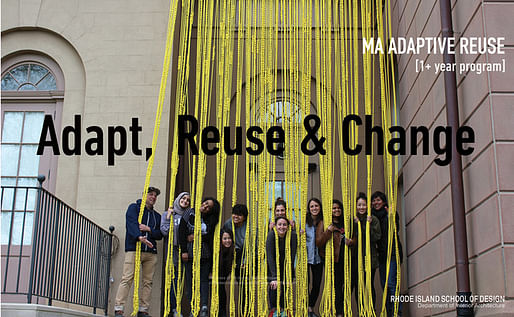

At the intersection of architecture, conservation and design, RISD’s Interior Architecture department takes an innovative approach to the reuse and transformation of existing buildings. Advanced design studios focused on adaptive reuse are central to both the undergraduate and graduate programs. And unlike the fields of interior design and decoration, interior architecture looks less at the application of surface materials than at understanding the design of buildings from the inside out.
In the studio, students use digital and manual means to research and recommend design alterations and renovations that give existing buildings new life. Studios focus on a wide range of approaches, from domestic to retail design to theater/production design to issues of preservation and conservation.

“Students in our department are engaged in a rich and expansive discipline focusing on the reuse and transformation of existing structures,” says Department Head Liliane Wong. “Through a wide breadth of design in the built environment, this exploration includes interior interventions, architectural addition and refurbishment, installation, exhibit design, urban transformations and community engagement – using adaptive reuse as the primary tool.”
“A building at the end of its lifespan faces three possibilities,” adds Graduate Program Director Markus Berger, “demolition, preservation or adaptive reuse. Our program has focused on adaptive reuse since 1947, when architect/designer Ernst Lichtblau (a student of Otto Wagner) assumed leadership of the department and essentially launched RISD’s Interior Architecture program.” The department has since become a leader in the field of adaptive reuse and interior studies and began publishing the internationally recognized Int|AR Journal on Interventions and Adaptive Reuse in 2009.

Like the Interior Architecture department itself, Int|AR focuses on issues of preservation, transformation, alteration and interventions in the fields of architecture, interior studies and practice, but also in the realms of urban and landscape design. It also highlights their repercussions in the history and theory of architecture, urbanism, art and design.
The Department offers 3 individually different graduate programs:
MA in Adaptive Reuse

This program provides a unique specialist design education on the subject of adaptive reuse as a post-professional study to a first degree in Architecture. The program aims to establish a clear aesthetic, theoretical and technological framework for the study of adaptive reuse, in order that graduating students are properly equipped to engage in the practice of working with existing buildings, structures and spaces. It enables students to develop strategies in their work which recognize the importance of social and environmental responsibility.
MDes INTERIOR STUDIES in Adaptive Reuse
The 2+ year Master of Design (MDes) in Interior Studies [Adaptive Reuse] provides a unique design education on the alteration of existing structures through interior interventions and adaptive reuse. The program establishes a clear aesthetic, theoretical and technological framework for the study of interior studies and adaptive reuse. Graduating students are properly equipped to engage in this subject in the general design field and to develop strategies in their work which recognize the importance of social and environmental responsibility.
MDes INTERIOR STUDIES in Exhibition & Narrative Environments

The study of Exhibition and Narrative Environments has been a part of our departmental studio offerings for many years. Our department has hosted annual studios specific to the design of the narrative environment that featured collaborations with the key members of the RISD Museum, the RISD Department of Graphic Design and Brown University, in particular, the Haffenreffer Museum and the John Nicholas Brown Center. The new option on Exhibition and Narrative Environments consists of an MDes curriculum supported by courses offered in these other disciplines, formalizing the existing relationships with these departments.
Graduate students in the program take their work to the next level. The culmination of each graduate student’s work in the department is his or her design thesis, an opportunity to synthesize accumulated knowledge on issues of design, reuse and preservation and to formulate and test a design hypothesis through a self-created design project. Students develop a proposal that describes their design intent, the nature of the proposed investigation, a design program and an existing project site through which their design intervention is executed.

RISD’s Interior Architecture alumni go on to find creatively satisfying work around the world. Some launch their own practices designing residential and/or commercial interiors, while others join larger established firms or smaller studios. In addition to practicing as interior architects, alumni also go on to make a mark professionally as sustainability specialists, set designers, educators, exhibition designers, fine artists and more.
For more information, visit:
http://intar-journal.risd.edu/
No Comments
Block this user
Are you sure you want to block this user and hide all related comments throughout the site?
Archinect
This is your first comment on Archinect. Your comment will be visible once approved.